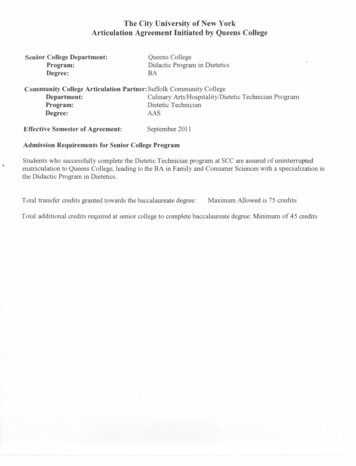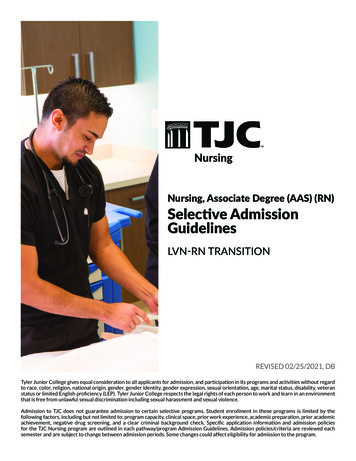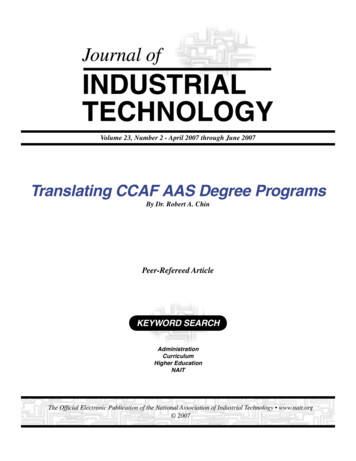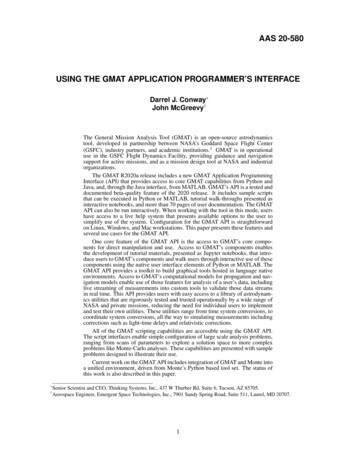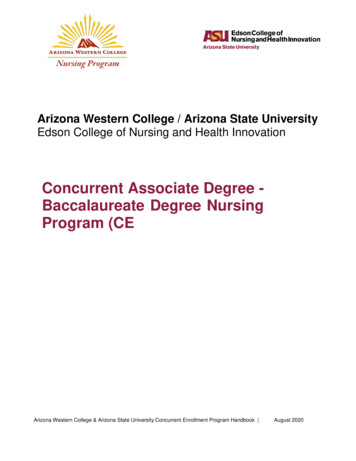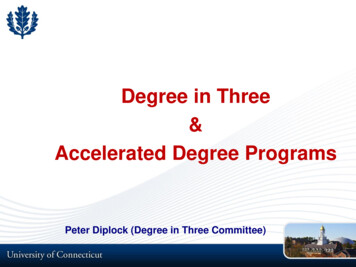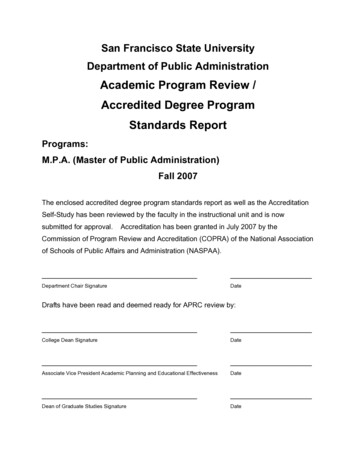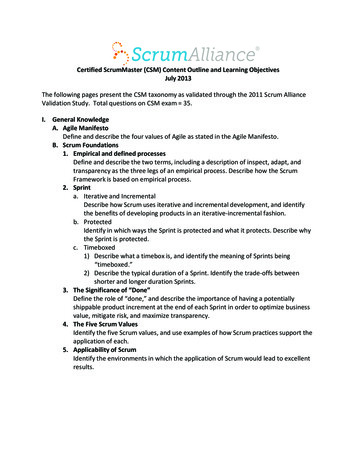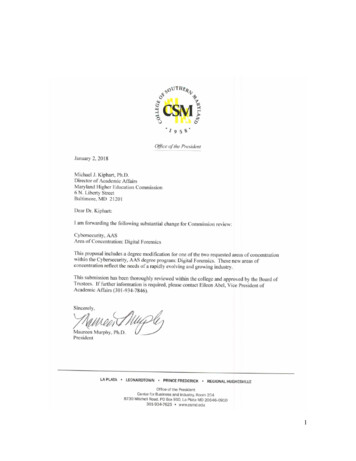
Transcription
1
2
The mission statement of the College of Southern Maryland (CSM, 2015) inspires thedevelopment of close partnerships among the college and its tri-county communitystakeholders. The institutional commitment to “meet the diverse needs of students and thecommunity” through “accessible, accredited, affordable, and quality learning opportunities for career enhancement, and personal growth“ aligns with the programmatic realities for the redesignedCybersecurity AAS degree program (CSM, 2015).The following is a description of the proposed changes:This degree modification will incorporate two areas of concentration within the degree program:Digital Forensics and Network Security.Careful consideration was made to design the first semester to be common for both areas ofconcentration. This provides students with the same preparation for study while also providing themwith the opportunity to explore the fields of network security and digital forensics before committingto an area of concentration. Further, the sequencing of the courses was determined so that studentswould have a well-rounded foundation that will ensue a successful progression through the program.Two new courses are being proposed to support the tracks. They are:Digital Forensics Track: ITS-2560 Digital Forensics IIITS-2565 Malware AnalysisIn addition, the program will require the creation of a new course to support both programs.The new course will be the combination of two older courses and will incorporate the corefundamentals of the industry A certification. The new course will be entitled ITS-1050 (A Computing Essentials).The Cybersecurity AAS program is consistent with CSM’s Strategic Goal #2, which is topromote student success by providing outstanding education and related support services that helpstudents achieve their goals (CSM, 2015). The new program will serve to increase graduatesatisfaction with job preparation.This program redesign will “effectively serve a changing student population and emergingworkforce” (CSM, 2015). The new areas of concentration in Digital Forensics and Network Securityreflect the needs of a rapidly evolving and growing industry. The recommendations enclosed arereflections of these elements and are consistent with the College’s Vision, “To transform livesthrough lifelong learning and service” (CSM, 2015).A new full-time Cyber\Computer Science faculty member and program coordinator wasrecently hired to teach the technical courses, manage the cyber lab, and promote the growth of theprogram.3
The availability of an in-demand, STEM, career path, in an ever-evolving cybersecurityfield, will attract both traditional and returning adult students, those entering a new field ofopportunity as well as workers changing or upgrading skills. These changes are evident in CSM’senrollment records\statistics (Maryland Higher Education Commission, 2014). An examination of thedemographics of our current student population reflects these realities and supports the needsidentified in the 2014 Maryland State Plan for Post Secondary Education, “graduating a morediverse population of students in these critical disciplines.” (MHEC, 2014).The redesigned degree in Cybersecurity at CSM is consistent with the elements of the 2014Maryland State Plan for Postsecondary Education. Much of our focus in curriculum developmentaddressed the advisories cited in this document. All the goals were utilized as required criteria, butconsiderable attention was given to the Governor’s Priorities and Goal #5: Economic Growth andVitality (MHEC, 2014).Citations in the State Plan (MHEC, 2014) also address the need for post secondaryinstitutions to strive for academic excellence and effectiveness. The very nature of this charge is todevelop student-centered learning bolstered by the partnerships with the various media employers inour region. This format increases experiential learning through internships and other hands on jobrelated activities assuring workplace readiness.CSM’s Cybersecurity AAS program will offer courses that, taken together, enable ourstudents to matriculate and earn their AAS degree. Formative and summative evaluations are anessential value of the educational process at CSM, and are a viable part of the new CSM program.Students are held to standards that are reflective of academic and professional systems, while thestructure and operation of the program provides the environment to support the achievement of thesestandards.Our cybersecurity advisor council feedback indicates that employers are interested inhelping to develop the program, which will include the creation of internships and otheropportunities. These are extremely important as they provide students enrolled at CSM incybersecurity both vital experience and opportunities for networking. In addition, these opportunitieswill increase student’s marketability, especially if a clearance is issued during an internship.To expand our geographic reach, stimulate enrollment and provide increased access to thisnew curricular option, the cybersecurity program intends to incorporate alternative means of coursedelivery. The program intends to provide traditional face-to-face courses complimented by offeringsthat are hybrid or fully online by form. The College of Southern Maryland has demonstrated successin delivering instruction by alternative methods, increasing flexibility and effective use of newtechnologies. The Division of Distance Learning and Faculty Development (DLF) support the facultyin developing high quality, accessible and effective teaching and learning environments.To facilitate these goals, the DLF staff provides service to faculty including planning,consulting, training, and support. The DLF staff makes available the resources necessary toincorporate instructional technologies into their traditional or distance learning courses. As such, theDLF staff will contribute significantly to the delivery of all new courses in Engineering Technologyby providing the faculty with the necessary support structures to enhance student success in their4
delivery, particularly those identified for distance learning, be the methodology fully on line orhybrid.In summary, the new degree in Cybersecurity at the College of Southern Maryland asproposed is consistent with and reflective of the current Maryland State Plan for PostsecondaryEducation (MHEC, 2014).Cybersecurity is currently ranked as one of the fastest growing fields in the globalmarketplace (Kauflin, 2017). The demand for qualified candidates is strong due to a shortage ofaround 2 million cybersecurity professionals (ISACA, 2017). Maryland and particularly SouthernMaryland is no exception to the cyber professional shortage and demand resulting demand.The Maryland Department of Business & Economic Development (MDBED) (n.d.) notesthat “cybersecurity and information innovation technologies represent an unparalleled economic andemployment growth opportunity for Maryland.” The Cyber Pathways Across Maryland (n.d.) groupquantified this growth rate as 41% over the next 8 years. The Maryland State Plan for PostsecondaryEducation notes, “colleges and universities should continue to prepare students for careers in highdemand, cutting-edge industries such as biotechnology, cyber security, and sustainable energy”(MHEC, 2014). To support this growth the state and federal government has invested a significantamount of money into cyber programs, including the College of Southern Maryland, to develop highquality cyber education programs.This program redesign is a result of this demand. Our program will provide students withthe skills to seek employment with state, local, and federal agencies in additional to privatecompanies. Particularly attention is being directed to develop the skills required by U.S. Navy CyberCommand and the U.S. Cyber Command, both which are based in Maryland (MDBED, n.d.). Thedemand for these two agencies in particular represents a great opportunity for our students as thedemand is so high that there are talks of waiving boot camp requirements for cyber recruits(Gallagher, 2017).The table below demonstrates the anticipated growth of cybersecurity in Maryland:Maryland: Cybersecurity Growth2014 Employment Estimate*2024 Projected Employment% ChangeProjected Annual Openings86,210113,75031.5%4,100Figure 1. Spotlight on Cybersecurity. Department of Labor, Licensing and Regulations (DLLR), (2017).A projected growth rate of 31.5% over the given span is quite significant. This number maybe rather conservative given the large population of government agencies and contractors that aretasked with supporting the nation’s cyber interests. In addition, “Maryland’s 11,600 informationtechnology businesses are annually awarded 10.36 billion in federal contracts and generate 39.55billion in economic activity, making it one of the nation’s leaders and a major economic engine forthe state” (Maryland, 2017).5
STUDENT CHARACTERISTICSSpring 2014 – Spring 2017Program - AAS.CYBER.SECURITYGrowth (All Campuses): 74 students, 80.4%Growth 4-Year (2014-2017): 100%Figure 2. Student Characteristics. College of Southern Maryland, (2017).The following community colleges have programs in cybersecurity, network security,and/or digital forensics:CYBER SECURITY DEGREES AT MARYLAND COMMUNITY COLLEGESInstitutionAnne l CommunityCollegeCollege ofSouthernMarylandCommunityCollege ofBaltimore CountyFrederickCommunityCollegeGarrett CollegeProgram NameInformation Assurance & CybersecurityDegree OfferedAssociates DegreeCybersecurityAssociates DegreeCybersecurityAssociates DegreeCybersecurityAssociates DegreeCybersecurityAssociates DegreeCybersecurityAssociates DegreeCybersecurityAssociates llegeMontgomeryCollegeCybersecurityAssociates DegreeInformation Assurance & CybersecurityAssociates DegreeCybersecurityAssociates DegreePrince GeorgesCollegeCybersecuritySource: Maryland Higher Education Commission, Finding a Majorhttp://www.mhec.maryland.gov/utilities/search major.aspThe above programs are all similar in providing students with the skills and knowledge togain employment in entry-level positions in various areas of cybersecurity. CSM’s program is6
designed with local workforce needs in mind, while still offering students with the education requiredto pursue non-Navy or DOD job opportunities in other fields of cybersecurity such as lawenforcement and civil ligation (e-discovery).This degree program prepares students who are currently employed in the cybersecurityfield, including active law enforcement, as well as those without prior work experience to developthe skills and knowledge required of practitioners in a variety of cybersecurity settings.The first semester is the same for all students in this program. The first semester is designedto provide all students with a basic foundation in computer theory. The second semester is wherestudents begin to explore cybersecurity concepts. At the conclusion of the second semester thestudent will select, which track they wish to pursue. This ability to select a track will provide studentswith the options to meet both their educational and specific career goals.The tracks are critical to ensuring that the educational plan supports the students careergoals considering that cybersecurity is not a homogenous field. The previous degree plan failed torealize this reality, which has required our students to seek additional training in order to seek gainfulemployment in certain cybersecurity positions. The addition of the tracks also expands our ability tocreate specific and meaningful relationships with various regional employers.There is no impact to the uniqueness, identities and missions of HBIs. The only othercollege in the tri-county area is St. Mary’s College.There is no impact to the uniqueness, identities and missions of HBIs. The only othercollege in the tri-county area is St. Mary’s College.The program description and requirements are as follows:No. of Credits: 60This degree program prepares students who are currently employed in the cybersecurityfield as well as those without prior work experience to develop the skills and knowledge required ofpractitioners within a variety of cybersecurity related settings.The first semester is the same for all students in this program. The first semester is designed7
to provide all students with a basic foundation in computer theory. The second semester is wherestudents begin to explore cybersecurity concepts. At the conclusion of the second semester thestudent will select, which track they wish to pursue.Students pursuing the digital forensics track will navigate through the entire digital forensicscourse sequence and upon completion will have sufficient knowledge to sit for the Global CertifiedForensic Examiner (GCFE) and Computer Hacking Forensic Investigator (CHFI) industrycertifications. This track will place special emphasis on the knowledge, skills, and abilities to conductcivil and/or criminal digital forensics investigations and to develop and administer policy in supportof digital forensic programs.Regardless of the track that students select, all students will take classes that will help toprepare for the following entry level cybersecurity industry certifications: CompTIA A , CompTIASecurity , CompTIA Linux , and Cisco Certified Entry Networking Technician (CCENT).Students will be taking courses in this program through several course delivery formats.Since it is imperative that students obtain hands-on experience with the various tools, technologiesand techniques employed in the cybersecurity field, some courses will only be offered in a face-toface lab environment. Courses not identified as a program core may be offered in an online onlysection.It should be noted that oral and written communication skills are emphasized throughoutthis program. Both tracks will require several courses in writing and communications. In addition,students will have multiple learning opportunities to improve soft skills by completing activities suchas developing a resume or portfolio, preparing for a job interview, and delivering projectpresentations.This program has been designated as a CAE-CDE 2Y - National Centers of AcademicExcellence in Cyber Defense 2-Year Education by the National Security Agency (NSA) andDepartment of Homeland Security (DHS)The maximum number of credits accepted in transfer from other institutions to this program is 45.The recommended program sequence is as follows:First SemesterITS-1050 – A Computing Essentials (3) (NEW COURSE)ITS-2511 – Networking I (3)Biology/Physical Science (3): Acceptable - See Gen Ed Listing (3)ENG-1010 – Composition and Rhetoric (3)Mathematics – Acceptable - See Gen Ed Listing (3)Second SemesterITS-1960 – Introduction to Linux (3)ITS-2090 – Computer Security (3)ITS-2516 – Networking II (3)ITS-2555 – Digital Forensics I (3) (NEW COURSE)ENG-2050 – Business and Technical Writing (3)Third SemesterITS-1110 – Program Design and Development (3)ITS-2545 – Information System Security (3)ITS-2565 – Digital Forensics II (3) (NEW COURSE)COM-1250 – Introduction to Interpersonal Communication (3)PHL-1150 – Cyber Ethics (3)8
Fourth SemesterITS-2500 – Ethical Hacking and Penetration Testing (3)ITS-2526 – Networking IV (3)ITS-2536 – Networking Infrastructure and Defense (3)ITS-2950 – Cybersecurity Capstone (3) (NEW COURSE)Social Science (3): Acceptable - See Gen Ed Listing (3)Cybersecurity, AASGeneral Education3 credits English Composition3 credits Arts/Humanities3-4 credits Biological/Physical Sciences3 credits Social/Behavioral Sciences3 credits MathematicsENG-1010 English Composition (3)COM-1250 Introduction to InterpersonalCommunication (3)Biological/physical sciences (3 credits)Select 3 credits from the General EducationCourse ListSocial/behavioral sciences (3 credits)Select 3 credits from the General EducationCourse ListMathematicsSelect 3 credits from the General EducationCourse ListOther General Education (from above categories)(3 credits)PHL-1150 - Cyber Ethics (3)Major RequirementsITS-1050 A Computing Essentials (3)ITS-2511 Networking I (3)ITS-1960 Introduction to Linux (3)ITS-2090 Computer Security (3)ITS-2516 Networking II (3)ITS-2500 Ethical Hacking and PenetrationTesting (3)ITS-2536 Networking Infrastructure andDefense (3)ITS-2545 Information Systems Security (3)ITS-2950 Cybersecurity Capstone (3)ENG-2050 Business and Technical Writing (3)Major Requirements 30Digital Forensics ConcentrationITS-1110 Program Design and Development (3)ITS-2555 Digital Forensics I (3)ITS-2560 Digital Forensics II (3)ITS-2565Malware Analysis (3)Concentration Credits 12General Education 18Credit total 609
Course descriptions for the required and technical elective courses are provided below:COM-1250 – Introduction to Interpersonal Communication (3)Prerequisite: ENG 0900 and RDG 0800 or FYS 1010TStudents are able to combine theory and application of communication principles involvedin initiating, developing, and maintaining a relationship. Aspects of one-to-one and smallgroup communication are explored including perception, self-concept, listening,intercultural and gender communication, and conflict management. College-level writingskills are recommended.ENG-1010 – Composition and Rhetoric (3)Prerequisite: ENG 0900; and RDG 0800 or FYS 1010T; or placementStudents in this course complete their first semester college-level composition course.Students focus on planning, organizing, and developing a variety of argumentativecompositions. Students practice the conventions of written Standard American English,gain information literacy skills, and learn research and documentation techniques includingconducting online and print research and documenting sources. By the end of the semester,students demonstrate their ability to write a unified and coherent argument-based essay ofabout one thousand words that incorporates research and is nearly free of grammatical,mechanical, and structural errors. Students should refer to the schedule of classes forsections of this course taught in a computer lab. Students must pay an additional lab feewhen taking this course in a computer-assisted classroom. Students may earn credit for thiscourse through CLEP or Advanced Placement Examination. A minimum grade of “C” isrequired to pass the course.ENG-2050 – Business and Technical Writing (3)Prerequisite: ENG 1010Students develop writing skills through composing a variety of clear, effective memos,letters, and reports. Subject matter for the papers may come from the student’s occupation orinterests, whether scientific, technical, or non-technical. Students should refer to theschedule of classes for sections of this course which are taught in computer labs.ITS-1050 – A Computing Essentials (3) (NEW COURSE)Prerequisite: RDG 0800 or FYS 1010TStudents gain knowledge and practical experience with PC hardware and peripherals,mobile device hardware, networking and troubleshooting, hardware and networkconnectivity issues. Students also gain practical experience installing and configuringpopular operating systems. Students will be introduced to topics in security, thefundamentals of cloud computing and operational procedures. This course helps students toprepare for the CompTIA A Certification.ITS-1110 – Program Design and Development (3)Prerequisite: RDG 0800 or FYS 1010T10
Students learn to solve business-oriented problems with emphasis on structured and objectoriented programming techniques. Design tools are used to develop pseudo-code,flowcharting and 3D interactive environments. Students are introduced to several softwarepackages that may be used to develop pseudo-code, flowcharts and interactive 3Denvironments. For students who plan to use personal computers, this course may havespecific computing requirements. Please refer to the Quick Link for ComputingRequirem
The redesigned degree in Cybersecurity at CSM is consistent with the elements of the 2014 Maryland State Plan for Postsecondary Education. Much of our focus in curriculum development . Information Assurance & Cybersecurity Associates Degree Carroll Community College Cybersecurity Associates Degree Cecil Community College Cybersecurity .
